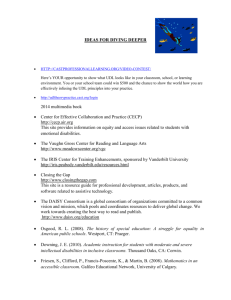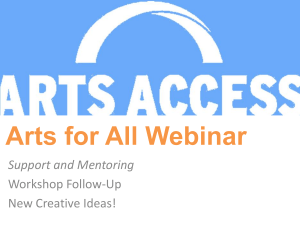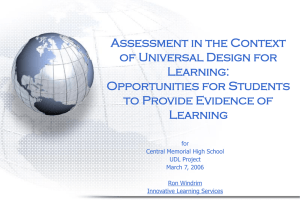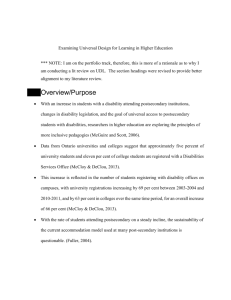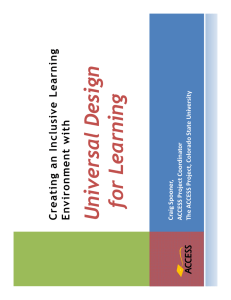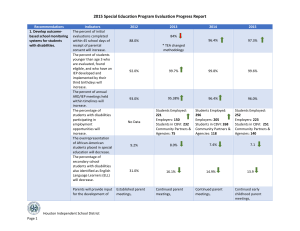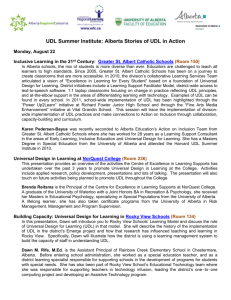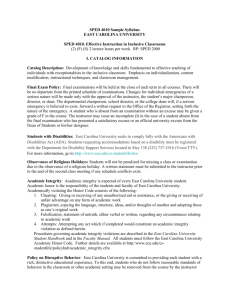KC%20Books%20-%20annotated%20list
advertisement
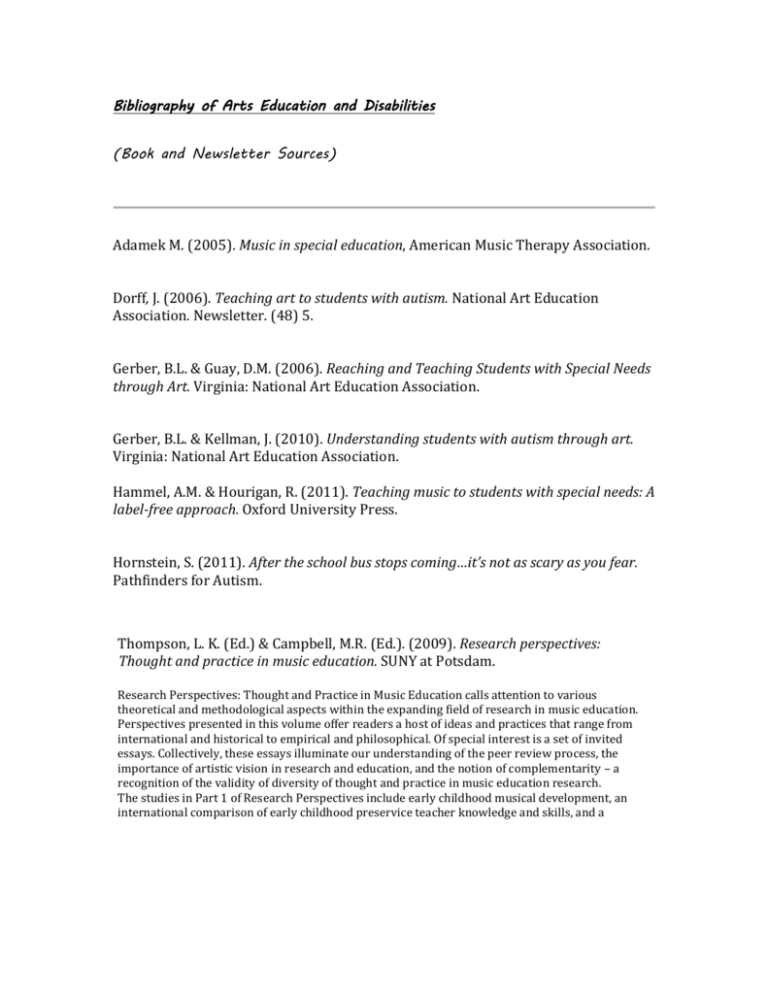
Bibliography of Arts Education and Disabilities (Book and Newsletter Sources) Adamek M. (2005). Music in special education, American Music Therapy Association. Dorff, J. (2006). Teaching art to students with autism. National Art Education Association. Newsletter. (48) 5. Gerber, B.L. & Guay, D.M. (2006). Reaching and Teaching Students with Special Needs through Art. Virginia: National Art Education Association. Gerber, B.L. & Kellman, J. (2010). Understanding students with autism through art. Virginia: National Art Education Association. Hammel, A.M. & Hourigan, R. (2011). Teaching music to students with special needs: A label-free approach. Oxford University Press. Hornstein, S. (2011). After the school bus stops coming…it’s not as scary as you fear. Pathfinders for Autism. Thompson, L. K. (Ed.) & Campbell, M.R. (Ed.). (2009). Research perspectives: Thought and practice in music education. SUNY at Potsdam. Research Perspectives: Thought and Practice in Music Education calls attention to various theoretical and methodological aspects within the expanding field of research in music education. Perspectives presented in this volume offer readers a host of ideas and practices that range from international and historical to empirical and philosophical. Of special interest is a set of invited essays. Collectively, these essays illuminate our understanding of the peer review process, the importance of artistic vision in research and education, and the notion of complementarity – a recognition of the validity of diversity of thought and practice in music education research. The studies in Part 1 of Research Perspectives include early childhood musical development, an international comparison of early childhood preservice teacher knowledge and skills, and a psychohistoric examination of developmentally appropriate practice. Part II is comprised of studies focused on psychometrics of motivation, and professional development of practicing music educators. This volume is a significant addition to the libraries of Colleges of Education and Schools of Music, as well as an important reference for music scholars and educators, researchers, and graduate students who are concerned with advancing both the scope and quality of research in the study of music teaching and learning. ________________________________________________________________________________________________ Thompson, L. K. (Ed.) & Campbell, M.R. (Ed.). (2008). Diverse methodologies in the study of music teaching. SUNY at Potsdam. As a set of studies, Diverse Methodologies represents and reflects the music education research community at a truly unique moment. The collection demonstrates the profession's increased motivation, willingness, and desire to expand and enhance the research base and traditions in the study and practice of music education. This volume is an important addition to the libraries of Colleges of Education and Schools of Music, as well as music scholars and educators, researchers, and graduate students who are concerned with advancing both the scope and quality of research in the study of music teaching and learning. _________________________________________________________________________________________________________________________________ Glass, D. (2010). Contours of inclusion: Inclusive arts teaching and learning. VSA The purpose of this publication is to share models and case examples of the process of inclusive arts curriculum design and evaluation. The first section explains the conceptual and curriculum frameworks that were used in the analysis and generation of the featured case studies (i.e. Understanding by Design, Differentiated Instruction, and Universal Design for Learning). Data for the cases studies was collected from three urban sites (i.e. Los Angeles, San Francisco, and Boston) and included participant observations, student and teacher interviews, curriculum documentation, digital documentation of student learning, and transcripts from discussion forum and teleconference discussions from a professional learning community. The initial case studies by Glass and Barnum use the curricular frameworks to analyze and understand what inclusive practices look like in two case studies of arts-in-education programs that included students with disabilities. The second set of precedent case studies by Kronenberg and Blair, and Jenkins and Agois Hurel uses the frameworks to explain their process of including students by providing flexible arts learning options to support student learning of content standards. Both sets of case studies illuminate curricular design decisions and instructional strategies that supported the active engagement and learning of students with disabilities in educational settings shared with their peers. The second set of cases also illustrate the reflective process of using frameworks like Universal Design for Learning (UDL) to guide curricular design, responsive instructional differentiation, and the use of the arts as a rich, meaningful, and engaging option to support learning. Appended are curriculum design and evaluation tools. (Individual chapters contain references.) ERIC: ED522677 ____________________________________________________________________________________________________________________ Glass, D. (2008). Contours of inclusion: Frameworks and tools for evaluating arts in education. This collection of essays explores various arts education-specific evaluation tools, as well as considers Universal Design for Learning (UDL) and the inclusion of people with disabilities in the design of evaluation instruments and strategies. Prominent evaluators Donna M. Mertens, Robert Horowitz, Dennie Palmer Wolf, and Gail Burnaford are contributors to this volume. The appendix includes the AEA Standards for Evaluation. (Contains 10 tables, 2 figures, 30 footnotes, and resources for additional reading.) [This is a proceedings document from the 2007 VSA arts Research Symposium that preceded the American Evaluation Association's (AEA) annual meeting in Baltimore, MD.] _________________________________________________________________________________________________ Hall, T. E. (Ed.), Meyer, A. (Ed.) & Rose, D. H. (Ed.). (2012). Universal design for learning and technology in the classroom, What works for special-needs learners series. Guilford Press Clearly written and well organized, this book shows how to apply the principles of universal design for learning (UDL) across all subject areas and grade levels. The editors and contributors describe practical ways to develop classroom goals, assessments, materials, and methods that use UDL to meet the needs of all learners. Specific teaching ideas are presented for reading, writing, science, mathematics, history, and the arts, including detailed examples and troubleshooting tips. Particular attention is given to how UDL can inform effective, innovative uses of technology in the inclusive classroom. _________________________________________________________________________________________________

